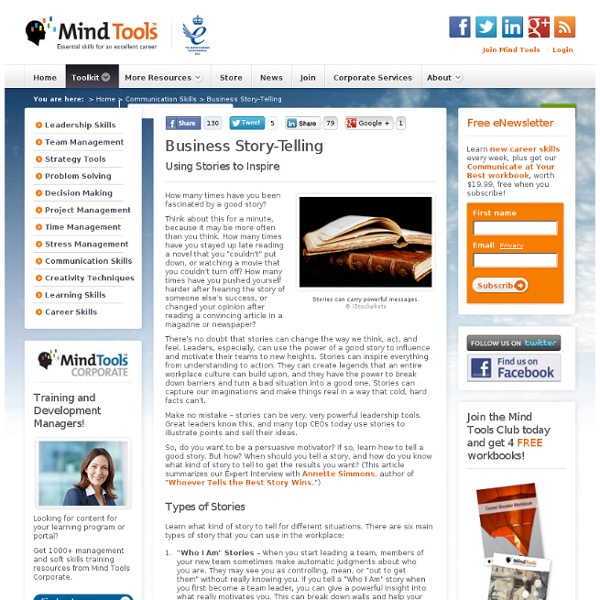How to Tell Your Business Story - Tuts+ Business Tutorial
Stories are what make us tick as human beings. We imagine our lives as a story, and doing so gives us meaning and purpose. Stories help us feel like we're part of something bigger than ourselves. A story tells the journey of a hero (or heroine) facing and overcoming a major challenge. Business is all about facing challenges. Telling powerful stories about who you are and how you help your customers makes you stand out from the competition. In this tutorial, I'll guide you through two key ways of telling your business story. First, we'll look at how to tell your business story from your point of view. Second, we'll look at why the customer is the real superhero in your business's story, and at how you can position yourself as their perfect sidekick. While I'll show you what it takes to start exploring your story, remember there is no right way to tell a story. On top of that, remember that while your business is trading, your business story is never done.
Business Storytelling: 21 Quotes To Inspire You To Tell Your Story
How to Tell a Great Story - Carolyn O'Hara
We tell stories to our coworkers and peers all the time — to persuade someone to support our project, to explain to an employee how he might improve, or to inspire a team that is facing challenges. It’s an essential skill, but what makes a compelling story in a business context? And how can you improve your ability to tell stories that persuade? What the Experts Say In our information-saturated age, business leaders “won’t be heard unless they’re telling stories,” says Nick Morgan, author of Power Cues and president and founder of Public Words, a communications consulting firm. Start with a message Every storytelling exercise should begin by asking: Who is my audience and what is the message I want to share with them? Mine your own experiences The best storytellers look to their own memories and life experiences for ways to illustrate their message. Don’t make yourself the hero That said, don’t make yourself the star of your own story. Principles to Remember Do: Don’t:
The #1 Tip to Telling Your Business's Story Online | Dave Kerpen
What's Your Story? Why a Passionate, Consistent Narrative Matters for Every Startup
Sara Blakely had her product--an undergarment that smoothed the contours of a woman's body, making clothes more flattering and comfortable. But she had yet to make her first sale. She managed to land a meeting with a buyer at a Neiman Marcus store in Dallas. Clad in a pair of formfitting white pants, Blakely invited the buyer to join her in the ladies' room, where she proceeded to demonstrate the difference in the way the pants looked--with her undergarments, which she had dubbed Spanx, and without. Three weeks later, Spanx was on the shelves. She pulled the same stunt with buyers for Bloomingdale's, Saks, and Bergdorf Goodman. The tale of the white pants has become a key component of the Spanx story, and Blakely still loves to tell it. "In a world where people have a lot of choices, the story may be the deciding factor." Before it has investors, customers, profits, press coverage, or even a perfected product, every startup has at least one valuable asset: its story. Omidyar was lucky.
How to tell your company's story infodoodles from ann handley of ma...
PRESERVE.us - About Us
America is full of tales waiting to be told. There are beautiful stories hiding in small towns and big cities, on suburban streets and rural roads. Great wisdom lives in the well-worked hands of aging craftspeople and in the eager words of young artisans. Our very history is whispered into the materials they use to make exquisite goods according to timeless standards of quality and care. That is the tradition we aim to preserve. How wonderful it is to discover something that has been cast aside, to pick it up and restore it to its original beauty. Sometimes we walk proudly. PRESERVE is all of us, together, championing the goods, makers and legends that instill meaning inside the moments of our lives. We aim to preserve the enduring traditions of meals, memories and merriment. We want to preserve the abiding custom of telling one’s own story through style and craftsmanship. We believe in preserving the messy worktables of the handmade life. We strive to preserve every meaning of home.
How to Write a Networking Email That Gets Responses
Social Media Daily To-Do List: 10 Essential Tasks
So your business has a Facebook, Twitter, Pinterest, LinkedIn AND Google Plus account. How in the world can you possibly keep up with this many Social Media accounts without working a million hours a day or paying top dollar for a Social Media manager? Often times companies think they can treat their social media accounts similar to their website in that they can just create an account and let it sit there while it grows on its own. However that is just not the case. Companies quickly realize that Social Media is a hands on time consuming job that can take up large chunks of time. Whether as a business owner you decide to manage your Social Media accounts on your own or you hire a Social Media manager it is a big job. By following the below daily checklist you will not only grow your Social Media presence but you will save time as well. 1. First things first, in order to do anything you need to take the first step and log into your accounts. 2. 3. Bad review on Yelp? 4. 5. 6. 7. 8. 9.



